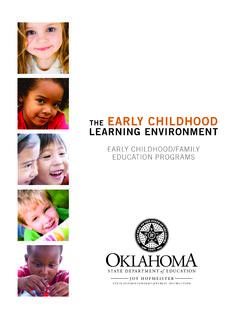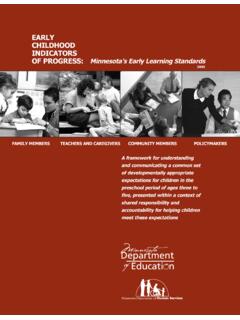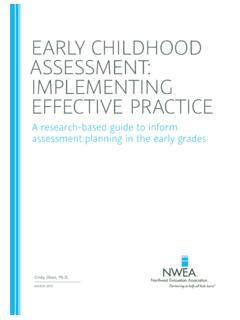Transcription of Encouraging Quality in Early Childhood Education and Care ...
1 1 Encouraging Quality in Early Childhood Education and Care (ECEC) RESEARCH BRIEF: working CONDITIONS MATTER What are working conditions ? working conditions in ECEC settings are often referred to as structural Quality indicators ( , wages, staff-child ratio, maximum group size, working hours, etc.) and other characteristics ( , non-financial benefits, team-work, manager s leadership, workload, etc.) that can influence the ability of professionals to do their work well and their satisfaction with the workplace, work tasks and nature of the job. What is at stake? Attracting, training and retaining suitably qualified ECEC staff is a challenge. Good working conditions are strong incentives for qualified staff to enter the profession. Structural Quality indicators have received ample attention because they can usually be regulated or guided at the national level. For staff Quality , it is also crucial that practitioners are motivated and supported in applying what they have learned.
2 The European Commission s Early Matters symposium (European Commission, 2009) concluded that many research findings indicate that, in addition to training and Education of staff, staff working conditions are important in providing safe, healthy and good learning environments for children. In spite of these findings, the ECEC sector is usually associated with relatively poor working conditions and poor compensation leading to high turnover rates. ECEC centres often experience turnover rates exceeding 40% annually, undermining the Quality of care (Moon and Burbank, 2004). Why do working conditions in ECEC matter? Research points out that the ability of staff to attend to the needs of children is influenced not only by their level of Education and training but also by external factors, such as their work environment, salary and work benefits (Shonkoff and Philips, 2000). working conditions can have an impact on staff job satisfaction and their ability to carry out their tasks; and their possibilities to positively interact with children, give them enough attention and stimulate their development.
3 Strongly associated with stable, sensitive and stimulating interactions with children are the context and conditions in which staff member works. One study found that low wages: i) effect the ways in which staff interact with children, and ii) are related to high turnover rates (Huntsman, 2008). High turnover rates can have a negative effect on ECEC Quality since staff provision is less stable, which, in turn, can impact child development. When staff members regularly change within a group of children, staff and children are less able to develop stable relationships; and nurturing, stimulating interactions take place less often (CCl, 2006). The body of research on the effects of working conditions on child development is not very extensive, and findings do not always point in the same direction. This is mainly because there is a complex inter-relationship between staff-child ratios, staff qualifications, Quality and type of provision that makes it difficult to single out the effect of a particular characteristic of working conditions (Sammons, 2010).
4 2 What matters most? Firstly, it is important to point out that more research is needed in this area. Available research findings focus on the effects on staff satisfaction rather than on child development. Many aspects of working conditions are found to be related to the Quality of ECEC services, while a few aspects have been found to be related to child development. Table 1 presents an overview of research findings, pointing to characteristics of working conditions that matter. Table 1. Which staff working conditions improve ECEC? Optimal staff working conditions Areas of improvement ECEC services Child outcomes 1. High staff-child ratio and low group size X X 2. Competitive wages and benefits X unclear 3. Reasonable schedule/workload X unclear 4. Low staff turnover X X 5. Stimulating and playful physical environment X unclear 6. Competent and supportive centre manager X unclear Note: Areas of improvement that remain unclear present important opportunities for future ECEC research.
5 Source: Ackerman, 2006; Burchinal et al., 2002; De Schipper et al., 2004; De Schipper et al., 2006; De Schipper et al., 2007; Diamond and Powell, 2011; Huntsman, 2008; Litjens and Taguma, 2010; Loeb et al., 2004; Moon and Burbank, 2004; Sheridan and Shuster, 2001; Sheridan et al., 2009; Torquati et al., 2007. Staff-child ratio Higher staff-child ratios, referring to a smaller number of children per staff, are usually found to enhance ECEC Quality and facilitate better developmental outcomes for children (Burchinal et al., 2002, De Schipper et al., 2006; Huntsman, 2008; Torquati et al., 2007). While there have been some older studies with contradictory results, the weight of evidence favours the conclusion that staff-child ratio in an ECEC setting is significantly associated with Quality (Huntsman, 2008). Findings on Quality can be summarised as follows. Better staff-child interactions and less stress for staff Larger staff-child ratios are associated with better working conditions and less stress.
6 Staff are found to be more supportive when they are responsible for a smaller group of children (De Schipper et al., 2006). A higher staff-child ratio improves working conditions within ECEC settings, as staff can give sufficient attention to different developmental domains and create more caring and meaningful interactions with children. As the number of children per staff member increases, staff spend more time in restrictive and routine communication with children and less in positive verbal interactions (Litjens and Taguma, 2010; Rao et al., 2003). Better child development Children become more co-operative in activities and interactions with larger staff-child ratios. They also tend to perform better in cognitive and linguistic assessments when staff-child ratios are higher. Furthermore, academic development seems to be enhanced by higher staff-child ratios, although there are not many (recent) studies that have investigated this topic (Huntsman, 2008; Sylva et al.)
7 , 2004). A limitation of the research mentioned above is that most findings are almost exclusively correlational and there have been very few experimental studies (Huntsman, 2008). An experimental study carried out by Chetty et al. (2011) found that even though smaller staff-child ratios of three-to-four-year-olds improved 3 outcomes, there were no long-lasting effects on adult earnings. However, the overall Quality of the ECEC setting did have an effect on adult earnings. High staff-child ratios are considered particularly important for younger children; there is evidence indicating that infants and toddlers especially benefit from high staff-child ratios (De Schipper, 2006). In many countries staff-child ratios have been regulated with higher staff-child ratios for the very young and lower ratios for older children (NICHD, 2002). Research is lacking, however, on exactly which ratio is most favourable to enhance teacher job satisfaction, ECEC Quality and child outcomes.
8 Nevertheless, many Early Childhood educators believe that anything less than a 1:3 or 1:4 ratio for children up to two years old is insufficient to allow staff to interact effectively with each child (Litjens and Taguma, 2010). Group size Increased process Quality , although the direct effect remains unclear Group sizes are often regulated, prescribing the number of children to be arranged and supervised as a group. Not all studies find effects of group size on the Quality of ECEC: effect sizes are usually small, and the size factor is often difficult to single out when staff-child ratios are included in the same analyses. Another research limitation on group size is that it rarely takes into account the age mixing of children, which may be an important factor (with homogeneous age groups being easier to handle). The overall research conclusion, however, is that group size has an effect on process Quality ( , staff-child relationship, staff-parent communication).
9 If staff experience their working conditions as more pleasant, this will result in more caring and stimulating behaviour (Huntsman, 2008; Burchinal et al., 2002; Clarke-Stewart et al., 2002). Classroom Quality and staff job satisfaction Research suggests that it is not only the staff-child ratio but also the number of adults in a classroom that impacts Quality and job satisfaction. The Quality of the classroom environment is found to improve with every additional adult in the room. When practitioners work together in a classroom, this provides opportunities for supervision, consultation and discussing work challenges (Goelman et al., 2006). Clear roles and expectations must be defined to optimise teamwork in ECEC settings. Under current practice, the hiring of assistants has generally failed to compensate for larger groups and less contact with teachers (Chartier and Geneix, 2006; Finn and Pannozzo, 2004). Remunerations: wages and other benefits Higher wages and better working conditions affect people s job satisfaction, work motivation and, indirectly, the Quality of their teaching, caring and interactions with children (Huntsman, 2008; Moon and Burbank, 2004).
10 Low wages leading to less process Quality for child development Research has indicated that where there are very low wages in ECEC, it impacts Quality primarily by preventing qualified and committed individuals from considering working in child care or Early Education in the first place (Manlove and Guzell, 1997). Low wages are, as mentioned above, related to high staff turnover rates (Moon and Burbank, 2004), which influence children s language and socio-emotional development as well as the relationships they form with practitioners (Whitebook 2002; Torquati 2007). Low wages are also correlated with the perception that working in the ECEC sector is not a high-status profession (Ackerman, 2006). Although pay in ECEC-related professions in most OECD countries is not very high (OECD, 2006), this is not the case in all OECD countries. In Scandinavian countries, for instance, where a bachelor s degree is needed to work as an ECEC teacher, staff receive better pay, and their job has a higher status than in 4 countries with lower pay.


















